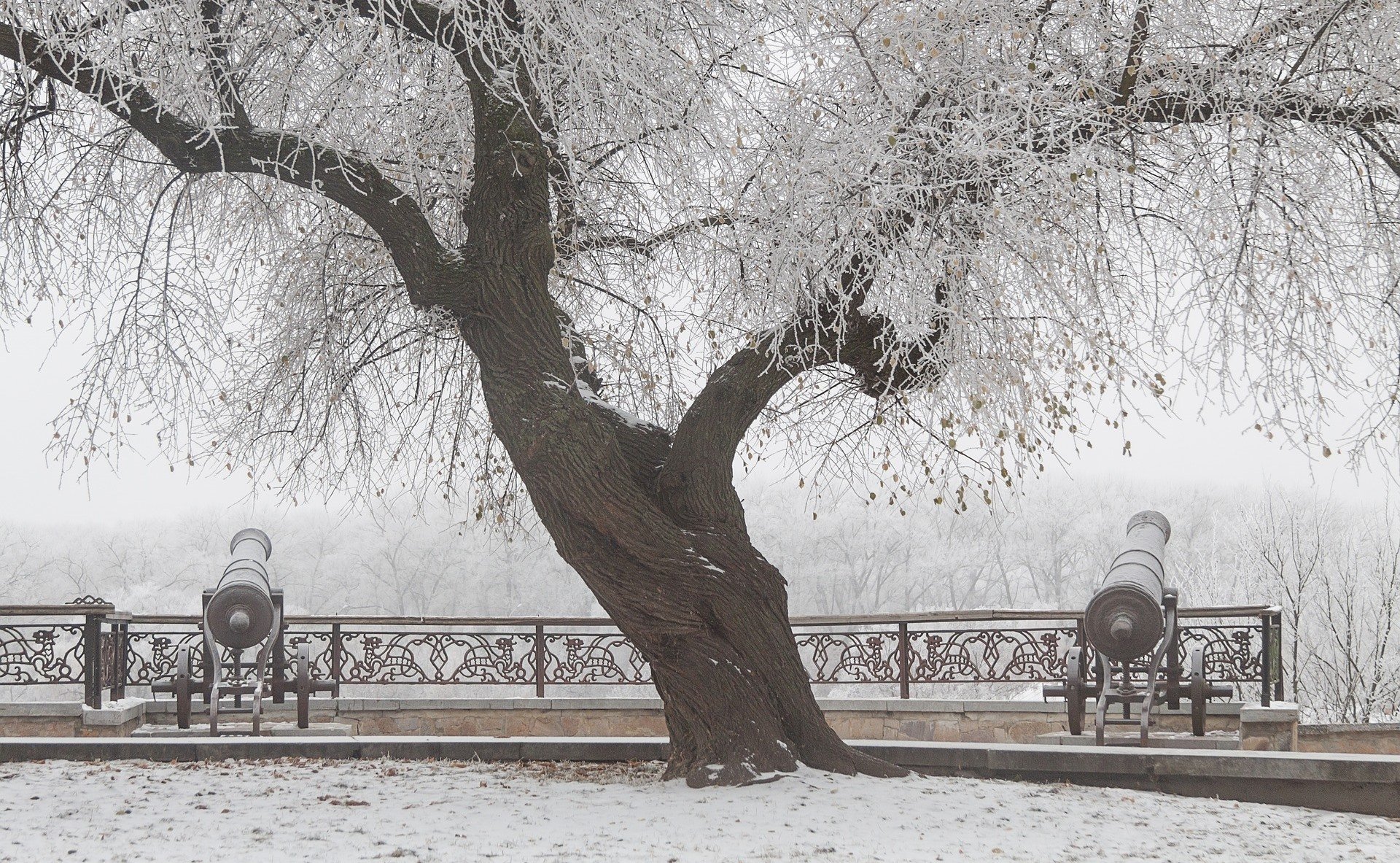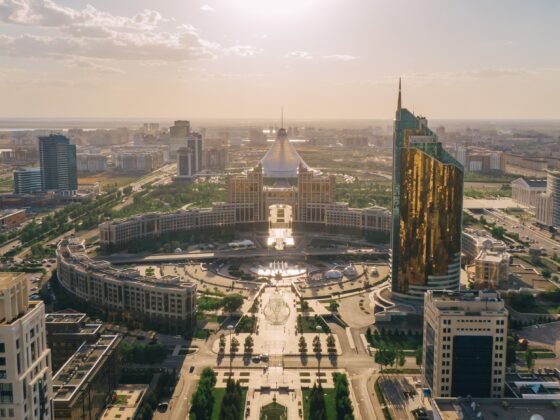(PONARS Eurasia Policy Memo) For seven years now, war on the territory of Ukraine has continued. It is fought militarily, diplomatically, and economically between the Ukrainian armed forces and the forces of the Russian-backed, self-proclaimed Donetsk and Luhansk People’s Republics (DPR/LPR). As any progress toward a stable ceasefire in eastern Ukraine has completely stalled since the last “breakthrough” agreement on July 27, 2020, Russia has gradually stepped up pressure on Ukraine and its Western allies. This has been a continuation of similar efforts since late 2013, bringing Europe now to the brink of a full-scale military confrontation in the form of Russia intervening in Ukraine.
In response to the latest escalation of the crisis, Ukraine adopted a doctrine of “national resistance,” according to which all men and women under 60 are subject to mobilization for military service. Ukraine has been strengthening its military capabilities along with military spending, which has increased steadily from $1.6 billion in 2013 to $4.1 billion in 2020 (4 percent of GDP) to $5 billion this year. Kyiv announced the ambitious goals of challenging Russian dominance in the Black Sea, returning Crimea to Ukraine (the “Crimea Platform”), rebuilding its Black Sea Fleet, and making significant investments in the construction of two naval bases in Mykolaiv and Berdyansk. What is missing, however, is a comprehensive approach to integrate all plans and efforts together to forge a stable peace with its neighbor. With no expansive strategy to bring the conflict to a conclusion, each new open battlefield consolidates Russia’s coercive diplomacy leverage(s) and makes a full-fledged war more probable.
The Cold Conflict in Donbas
The lack of progress in the implementation of the Minsk agreements and the reintegration of the DPR/LPR became either a defeat or success of President Volodymyr Zelensky’s foreign policy, depending on how such goals and the future statehood of Ukraine is seen. From one side, the Secretary of the National Security and Defense Council of Ukraine openly declares that the Minsk agreements are unfavorable for Ukraine, and then Deputy Prime Minister for Reintegration of the Temporarily Occupied Territories (who is currently the Minister of Defense of Ukraine) considers the uncontrolled territories of Donbas a “tumor” that will “infect” all of Ukraine.
On the other side, the Kremlin has an organized campaign to grant Russian citizenship to residents of the DPR/LPR. According to data from the Russian Foreign Ministry, as of May 2021, 530,000 of the 3.5 million registered residents of Donbas received Russian citizenship.[1] While opinion polls in Ukraine show that Ukrainian society is getting used to the fact that the end of the conflict in eastern Ukraine will be greatly delayed or will not take place at all, public opinion polls in Russia show an increase in the number of respondents who believe that the reintegration of the DPR/LPR will happen with Russia and not with Ukraine. The above demonstrates that a scenario of freezing the conflict without a resolution, and the non-reintegration of DPR/LPR into Ukraine, may become the most likely option.
Donbas and Crimea: Two Battlefields, One War
Russia recognizes Crimea and Sevastopol as two federal entities, whose status cannot be questioned, and DPR/LPR as parts of Ukraine, but Russia’s tactics in managing conflicts in eastern Ukraine and Crimea have been interlinked. Russia’s support for pro-Russian rebels in eastern Ukraine is its leverage to influence Ukraine’s domestic and foreign policy, including with respect to Crimea.
Yet, the conflict around Crimea and the conflict in the Donbas have demonstrated different dynamics.[2] The organized withdrawal of the Ukrainian army from Crimea began on March 24, 2014, ten days after the illegal referendum, whereas the conflict in eastern Ukraine has lasted for seven years.[3] The conflict in eastern Ukraine went through a phase of high intensity (2014-2015), low intensity (2016-2019), and freezing (2019-). According to the UN, from April 2014, about 13,300 people (3,375 civilians, 4,150 Ukrainian soldiers, and 5,700 rebels) have died as a result of the hostilities.
Kyiv’s policy differs in relation to annexed Crimea and the DPR/LPR. Ukraine introduced symmetric measures of an economic and trade blockade against the Donbas region and Crimea, but measures against the DPR/LPR are much stricter, such as prohibitions on economic activity, cooperation with local authorities, types of movement, etc. Accordingly, the level of intolerance of Ukrainian society toward internally displaced persons (IDPs) from Donbas is higher than toward IDPs from Crimea, making the former a more socially isolated group. Furthermore, there are significant differences in the military tactics implemented by Zelensky and former president Petro Poroshenko. In contrast to Poroshenko’s “leapfrogging” tactics of 2016-2019, Zelensky is heading for a deep freeze of the conflict in eastern Ukraine that can result in two scenarios.[4]
Two Freezing Scenarios
A Transnistrian scenario means the socio-economic reintegration of the de-facto state with the mother state without political integration. In Kyiv, any reintegration scenario that retains Moscow’s influence on Ukrainian foreign and domestic policy is considered unacceptable. Thus, the reintegration or “de-occupation” in the Ukrainian strategy toward Donbas and Crimea should be on Ukraine’s conditions, which were set out in a parliamentary bill submitted by Zelensky. The bill excludes the granting of special status to parts of DPR/LPR, excludes amnesty, restricts political and civil rights for categories of residents, expands the Ukrainian cultural space, continues the policy of Ukrainization, and imposes financial reparations on Russia.
Realizing that de-occupation on Ukrainian conditions is hardly possible, in his interview on the Ukrainian television channel Dom, which broadcasts in the DPR/LPR, Zelensky further outlined the priorities of Ukrainian policy toward that region. These were that reintegration would not come soon (making a comparison with the Berlin Wall saga), that Donbas would be a “depressed” territory, and that the pro-Russian population needed to leave for Russia. Indeed, to begin with, the economic calculations speak in favor of the reintegration (Transnistrian) scenario. A simple cost-benefit analysis demonstrates that the state of peace is more beneficial for the Ukrainian economy than a never-ending war. Indirect losses to the Ukrainian economy as a result of the war in Donbas amount to more than 15 percent of GDP, stemming from aspects such as broken economic chains, tax evasion, and loss of industrial assets and infrastructure.
The protracted conflict has already contributed to the marginalization of the Ukraine-controlled territories of Donbas. In 2013, the Donetsk region was ranked first in the country in terms of income per capita, but in 2019, it ranked second to last. The Luhansk region currently ranks last in terms of income, seven times less than Kyiv. Ukrainian-controlled Donbas regions are the most depressed of Ukraine, which creates a solid base for grievances. To address needs, the Ukrainian government plans to attract $20 billion in international aid to implement the “Concept of Economic Development of Donetsk and Luhansk Oblasts.” However, raising funds has been difficult without a conflict settlement and stable peace pathway. In addition, it is necessary to maintain and equip the Ukrainian army, which has 40,000 troops taking part in operations in Donbas. The Ministry of Defense budget for security and defense is now above 6 percent of GDP (in 2013, 1.6 percent of GDP), placing it in the top 35 countries in military-spending ratios.
Spending does not eliminate risks, which are many. If there is a reintegration route, the weak institutions of the Ukrainian state may not be able to accommodate the separatist territories, and the process itself may slow down or make impossible the proclaimed course of Ukraine toward its European and Euro-Atlantic integration. There is also the likely growth of radical right-wing sentiments in Ukraine, which would lead to clashes between far-right radicals and the population from DPR/LPR. Other issues would be significant expenses for restoring destroyed infrastructure, as well as a likely drop in the confidence of residents (and the electorate) in western Ukraine toward Zelensky. Either way, Ukraine’s hopes for peace in the Donbas are undermined by Russia employing its military-diplomacy tools, managed escalation-de-escalations, and threats and posture of military invasion.
Russian Levers
There is a broad consensus that Russia uses separatist entities established on the territories of Ukraine and Moldova as leverage to influence these states’ foreign and domestic policies. Comparing Transnistria and DPR/LPR, however, one can find important differences. Russia mainly uses socio-economic tools (trade, natural gas supplies, and investments) to support Transnistria, and political tools (pro-Russian voices) on elections in Moldova. Toward DPR/LPR, Russia mainly uses a coercive diplomacy toolset from escalations to threats of a full-fledged war, as we are seeing today. Many Ukrainians keep in mind that President Vladimir Putin has repeatedly said that Ukraine will cease to exist as a state if Kyiv attempts to return DPR/LPR by military force.
Russia and Russia-backed rebels use various forms of violence against Ukrainian citizens living in Donbas as a means of influence on Kyiv’s policies. Examples include keeping Ukrainian prisoners of war, throwing pro-Ukrainian activists in prisons and concentration camps, and using torture. Other pressures are restricting the freedom of movement of residents of Donbas, including a ban on travel for certain categories of the population.[5] There is also a ban on the entry of Ukrainian citizens into the territories of DPR/LPR, including on actual residents of the Donetsk and Luhansk regions. Last but not least, Moscow has forced the expropriation of property and passportization.[6]
For its part, Kyiv’s policies are vague and contradictory in civilian matters toward those in Donbas. On the one hand, Kyiv continues to pay pensions and other social benefits to Ukrainian citizens in the DPR/LPR and offers some benefits to IDPs, such as preferential admission to Ukrainian universities and partial compensation for housing costs. Kyiv does not recognize Russian citizenship issued to residents in the DPR/LPR. On the other hand, initiatives proposed by members of the parliamentary opposition to deprive citizens of dual citizenship (Ukrainian and Russian) of their Ukrainian citizenship are becoming more and more popular. Any potential major changes related to the legislation on obtaining/losing Ukrainian citizenship will greatly affect the character of the conflict.
If Russian passport holders fighting in the DPR/LPR armies are deprived of Ukrainian citizenship, the arguments in favor of the domestic nature of the conflict in eastern Ukraine will be significantly weakened. In turn, Kyiv will have more arguments to demand a change in the content of the Minsk agreements towards the recognition of Russia’s responsibility as a party to the conflict in eastern Ukraine.
Conclusions
As we begin 2022, the Ukrainian crisis remains clearly unresolved. Both the scenario of the reintegration of Donbas under the terms of the Minsk agreements and the scenario of its non-integration carry risks for Ukrainian statehood. From a tactical perspective, maintaining the status quo is the safest scenario for Kyiv, especially in the absence of ideas for conflict settlement that would be acceptable to both Moscow and the Ukrainian domestic opposition. From a strategic perspective, however, the lack of a strategy for resolving the problem of the DPR and LPR in a broader context of unsettled relations between Moscow and Kyiv and Moscow and the West, is, as many call it, the “sword of Damocles” hanging over Ukraine. Political confrontations and military conflicts would be easier for Kyiv to deal with if the Ukrainian state had a more consolidated, inclusive democracy resting on the unequivocal support of all its citizens. Without an all-embracing, strategic-thinking approach to conflict settlement—and while still building strong state institutions (that can resist Russian levers)—Ukraine will remain dependent on external military support and be vulnerable to geopolitical shifts.
Tetyana Malyarenko is Professor of International Security at the National University Odessa Law Academy, Ukraine. The author gratefully acknowledges research funding from the Erasmus+ Programme of the EU (Jean Monnet Project ‘‘Towards a More Secure Digital Europe: Multi-level Governance for Countering Online Disinformation and Hybrid Threats”).
[1] The procedure requires prior acquisition of citizenship of the unrecognized republics.
[2] For the purposes of this memo, this is understood not only as an interstate conflict that resulted in the annexation of the peninsula in 2014 but also as various clashes between Ukrainian and Russian ships at sea. See, for example, the Kerch Strait incident.
[3] According to the testimony of the former Minister of Defense of Ukraine Igor Tenyukh, out of 12,000 Ukrainian troops stationed in Crimea, 10,000 went over to the side of Russia.
[4] Leapfrogging tactics means small-scale military operations. By 2019, almost all gray zones and some territories transferred to the DPR/LPR under the Minsk agreements were occupied by the Ukrainian army.
[5] See the 2021 DPR Decree “On a temporary ban on leaving the territory of the DPR” and the 2021 DPR Decree “On restriction of movement across the borderline with Ukraine.”
[6] See the 2021 DPR Decree “On the identification, registration and acceptance into municipal ownership of ownerless immovable things and property.”
PONARS Eurasia Policy Memo No. 735











